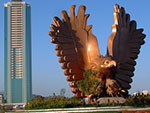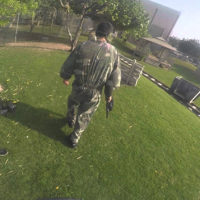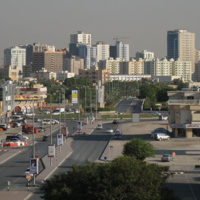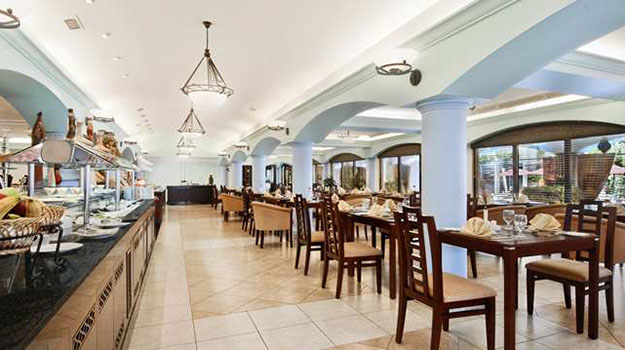 The most picturesque of all emirates, Fujairah is also the only emirate on the eastern coast of UAE along the Gulf of Oman and very popular among the locals expats and tourists alike. It is also the youngest of all emirates as it gained independence from Sharjah only in 1952. Fujairah is separated by the Hajar Mountains from the rest of the country.
The most picturesque of all emirates, Fujairah is also the only emirate on the eastern coast of UAE along the Gulf of Oman and very popular among the locals expats and tourists alike. It is also the youngest of all emirates as it gained independence from Sharjah only in 1952. Fujairah is separated by the Hajar Mountains from the rest of the country.
Fujairah covers approximately 1,450 km2 (which makes up about 1.4% of UAE’s area) and is the fifth largest emirate. Though mostly mountainous, Fujairah has a long coastline and many fantastic green oases, wadis hills and some desert areas and has more rainfall than the rest of the country, consequently allowing farmers to produce one crop every year in the region. It is composed of many towns and villages and is believed to be the home of the original immigrants from the south-east coast of the Arabian Peninsula to Syria.
The most important cities and villages in Fujairah are Bidiyah Al Qidfa, Al Gurfa Masafi Sharm, Al Bathnah, Murshid Dadna and Al Hail.
Famous for its stunning beaches and resorts, this emirate is also the most photographed for its natural beauty and its quaint and charming way of life. From fishing mending nets to tending to the old palm frond canoes (shasha), it often feels like time stands still in this place.
There are many tourist attractions in Fujairah. The clean beaches and the numerous water sports such as water surfing, yachting, swimming and deep sea fishing, make it an all-year round destination. Fujairah has the best snorkeling and scuba diving in the UAE, and weekends see hotels full with divers looking for a deep sea adventure.
HISTORY
Fujairah entered into treaty relations with Britain becoming the last of the emirates to join the Trucial States. On December 2, 1971, Fujairah joined the United Arab Emirates.
Fujairah is also home to the oldest mosque, Al Bidyah, in the United Arab Emirates which was built in 1446 of mud and bricks. It is similar to other mosques found in Yemen, eastern Oman and Qatar. The mosque has four domes (unlike the other similar mosques which have between seven and twelve) and lacks a minaret.
ECONOMY AND DEVELOPMENT
Fujairah’s economy is based on subsidies and federal government grants distributed by the government of Abu Dhabi (the seat of power in the UAE). Local industry consists of cement, stone crushing and mining. A spike in the construction activity helped the local industry to a large extent. Fujairah has a flourishing free trade zone while the Fujairah port is an important port for container liners with some of the world’s largest livestock shipping companies having set up their main holding station for cattle for the entire Arabian Peninsula here.
Fujairah is a major bunkering port with large scale shipping operations taking place every day. Shipping and ship related services are thriving businesses of the city. Due to the business friendly environment and ease of logistic support, ships trading from Persian Gulf anchor here for provisions, bunkers, repair & technical support, spares & stores before proceeding on long voyages. The city is also geographically well suited for such ship service related activities.
Government of Fujairah is major shareholder in National Bank of Fujairah, an UAE local bank, incorporated in 1982. NBF is in the areas of corporate and commercial banking, trade finance and treasury.
Fujairah’s combination of heritage, history, culture and natural wonders have attracted and induced investors fascinated by this emirate and its enormous natural wealth making Fujairah a favorite destination for investors looking for investment opportunities. This trend has been demonstrated by the emergence of numerous prominent investments in the Emirates in recent years.
Several big budget resorts are planned in the emirate and once the construction is completed it is expected to take the total number of five star hotels and villas over thousand. New resorts entertainment and shopping complexes have all added to an improved infrastructure to the emirate. Several rock and quarry industries have sprung up in the emirate, which contributes significantly to the economy of the emirate.
CLIMATE
The weather is seasonal, although warm for most of the year. In summer, the temperature climbs above the 40 °C (104 °F) degrees mark The months between October and March are cool with daytime temperatures averaging around 25 °C (77 °F) and rarely going above the 30 °C (86 °F). The winter period also coincides with the rainy season (which however is not guaranteed) but when it rains Fujairah experiences the bulk of its precipitation. Rainfall is higher than the rest of the UAE, partly because of the effect of the mountains that encircle the Emirate, and partly because the prevailing winds are easterly bringing with them water-laden clouds off the warm Indian Ocean.
The variability of the east coast climate is partly due to the presence of the Hajjar mountain range. As with other mountainous areas, precipitation is higher, and this allows for a more varied micro-environment in the area.
ARRIVING and GETTING AROUND
Travelling within the emirate and in surrounding towns of Khor Kalba, Khor Fakkan or Masafi has been made easy by the development of modern highways since gaining independence in 1971. Highways are funded by the federal government directly and are vital for the connectivity with the rest of the emirates. Private cars are the most commonly used methods of transport and shared taxis are available for public.
The taxis operate day and night, although there is no central booking system in place just yet. You can hail a taxi simply by standing at the roadside and flagging one down. All taxis are metered.
Fujairah is about two hours’ drive from Dubai. It is also quite easy to reach Fujairah from nearby Oman as the border is very close, although visitors to Fujairh from Oman are required to have entry visa to the UAE.
Buses run regularly between Dubai (Union Square) and Fujairah (Plaza Cinema). The tickets (AED25) can be purchased from the ticket window before boarding the bus.
Taxis run from Fujairah (next to the old cinema) to Dubai and Sharjah although it can be very expensive.
BONUS INFO – SHASHA
On the eastern coast of UAE, mainly Fujairah ( and also parts of neighbouring Oman) fishermen still use the shasha or bundle boats – the oldest known boat made of palm fronds tied together. It came into existence mainly due to lack of lumber – and the thriving palm trees. Usually, bundle boats are propelled by paddle, but this one uses oars. Shasha’s are usually not strong enough to mount an oar pivot, although here it doesn’t pose so much of a problem. Each oar rests against a single fixed hole and is held in place with a lashing.





